Idaho
Sandwiched between the pacific coast states and the rockies is a state that gives a vegetable pride of place. Yep, the car plates in Idaho carry the line ‘Famous Potatoes’ as this is where nearly a third of the US potato crop is grown and Idaho potatoes are served throughout the country. It is ironic that the worst potato that we have ever been served in a US restaurant was in Idaho Falls. Although the 1803-6 Lewis & Clark expedition passed through Idaho, the vague western border of the Louisiana Purchase left this area in dispute between the USA and Britain until in 1846 when the 49th parallel was agreed as the border. The modern day state boundaries were not established until 1863 and statehood was achieved in 1890. Although agriculture remains important, technology now contributes more to the economy of the state.
Snake River at Massacre Rocks State Park
Tourism is important for the economy of Idaho. Craters of the Moon National Monument, the Sawtooth Mountains and a tiny part of Yellowstone National Park are in Idaho, but it lacks the big hitting National Parks found in neighbouring states. Using the Internet we found a number of small State Parks to visit. Massacre Rocks State Park proved to be rather disappointing as it was little more than a camp site with a pleasant view over the Snake River. The Oregon Trail passed through a narrow passage in the rocks here and settlers fearing Indian ambush called it "Gate of Death" or "Devil's Gate". The Massacre Rocks name comes from an ambush in which 10 settlers died, but it actually happened to the east of the State Park.
Click on Minimap to navigate
DLU061218
Sherman Drive, Coeur d'Alene
It takes very little time to traverse the 80 kilometre (50 mile) wide northern panhandle of Idaho on the I-90, but there are several places worth visiting. Coeur d'Alene is the largest city in the panhandle, sitting on the shore of the lake of the same name. French Traders in the area gave the local Indian tribe the name Coeur d'Alene (Heart of Awl) in recognition of their shrewd bargaining. The town grew up as a supply and shipping point for nearby mines. Coeur d’Alene is now a tourist centre and home to a world famous golf course. Click Tab 2 to see the beach at Coeur d’Alene.
Idaho Falls & Mormon Temple
In 1860 gold was found and suddenly there was a gold rush to sparsely populated Idaho. Of course, more money was made by those selling to the miners than by the miners themselves. The Snake River was a major obstacle to the miners and in 1864/5 Matt Taylor constructed a log toll bridge over the river. The community that sprang up there was first called Taylor’s Bridge, then Eagle Rock. In 1891 the name became Idaho Falls after the falls below the bridge site since dammed to generate electricity. The city has a large Mormon population and the Mormon temple on the right was completed in 1945.
Niagara Springs
The Snake River winds its way right across southern Idaho. To the west of Twin Falls, near the town of Hagerman, water gushes from numerous points halfway up the cliff overlooking the northern bank of the Snake River. Although there are nowhere near that number, the area is known as Thousand Springs and many springs can be viewed from the Thousand Springs Scenic Byway, a section of the US 30 running along the south bank of the river. Niagara Springs is one of the largest of the springs with a flow of over 7 cubic metres (250 cubic feet) per second. This water disappeared underground into porous lava around 100 kilometres (60 miles) away near the Craters of the Moon National Monument. It takes around two centuries before it emerges along the Snake River. The clean water at a constant temperature of 14 degrees Centigrade (58 Fahrenheit) is ideal for fish farming and about 70% of the trout farmed in the USA is raised in this area.
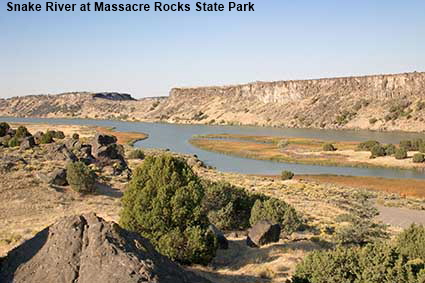
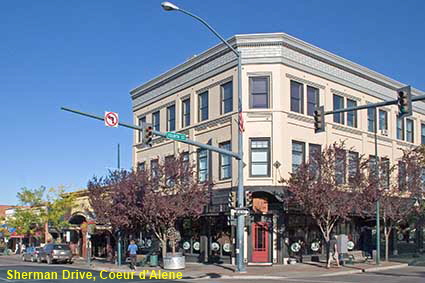
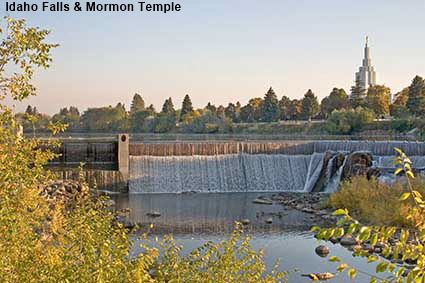
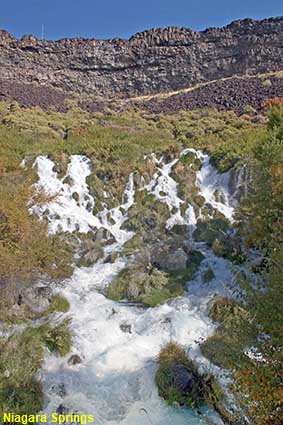
Malad Gorge State Park
Travelling along the Interstate 84 you will pass over this gorge just behind the point where this picture was taken, but from the Interstate you are unlikely to spot it. This sub unit of Thousand Springs State Park. has an area of 264 hectares (652 acres) and it encompasses the Malad Gorge from the point where the Malad River tumbles down falls into the Devils Washbowl to the point where it opens out to join the Snake River some 4 kilometres (2.5 miles) downstream. There is no access to the bottom of the 75 metre (250 foot) deep gorge, but there are trails running along the top.
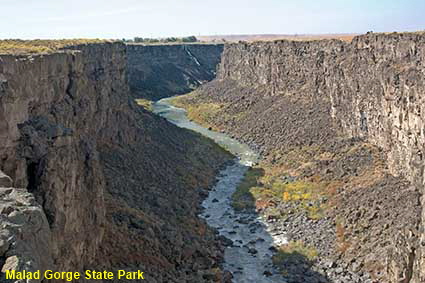
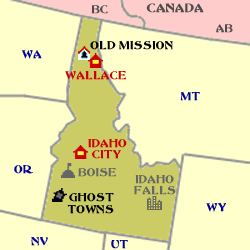


We have more pages on Idaho. Click below or on the Minimap:
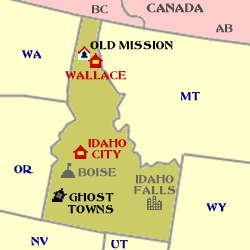

Idaho State Capitol, Boise
Boise had been the territorial capital since 1864 and it remained the capital after Idaho became a state in 1890. In 1905 the Idaho legislature passed the bill authorizing construction of a Capitol Building. Architects John E. Tourtellotte and Charles Hummel designed a capitol reminiscent to the Federal Capitol in Washington DC but they were also influenced by St. Peter’s Basilica in Rome and St Paul's Cathedral in London. Work on the dome and central part of the building started in 1905 and was completed in 1912. The wings containing the House and Senate Chambers were completed in 1920. The capitol is constructed from local sandstone, but inside it is faced with marble from across the USA and Italy. The most unusual fact about the Idaho State Capitol is that it is heated by geothermal water pumped from a source around 900 metres (3,000 feet) below ground. No other US State Capitol is heated this way.
© Mike Elsden 1981 - 2025
The contents of this page may not be reproduced in full or in part without permission